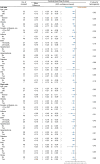Cerebral blood flow following successful living kidney transplantation: the VINTAGE study
- PMID: 39877207
- PMCID: PMC11773360
- DOI: 10.1093/ckj/sfae392
Cerebral blood flow following successful living kidney transplantation: the VINTAGE study
Abstract
Background: Chronic kidney disease (CKD) is a significant risk factor for cerebrovascular disease. However, there is limited research on how successful living donor kidney transplantation (LDKT) affects cerebral blood flow (CBF). This study aims to comprehensively investigate how LDKT influences CBF across various brain levels and regions.
Methods: Data from 53 recipients between 2016 and 2020 were obtained from the VINTAGE study conducted at our hospital. CBF was measured by level and region using single-photon emission computed tomography (SPECT), according to the Talairach brain atlas. The primary endpoint was the mean difference in CBF before and 1-year post-LDKT. Subgroup analysis using traditional risk factors assessed the heterogeneity of the effect on CBF in the frontal lobe region.
Results: LDKT improved blood flow in the anterior cerebral artery and middle cerebral artery but had less impact on the posterior cerebral artery. The most consistent improvements were observed in the frontal lobe region {left frontal lobe: -0.12 [95% confidence interval (CI) -0.18 to -0.05], P < .001; right frontal lobe: -0.13 [95% CI -0.21 to -0.05], P = .001}. Subgroup analysis showed a consistent effect of LDKT on frontal lobe CBF improvement, with no qualitative interaction observed.
Conclusions: LDKT contributes to the normalization of CBF, with improvement in anterior circulation and frontal lobe blood flow. To clarify the clinical significance of KT's CBF-improving effect, future studies should investigate the relationship between specific cognitive impairments (e.g. short-term memory, visuospatial ability, executive function) and CBF in each perfusion region.
Keywords: cerebral blood flow; cognitive function; frontal lobe; kidney transplantation; single-photon emission computed tomography.
© The Author(s) 2024. Published by Oxford University Press on behalf of the ERA.
Conflict of interest statement
The authors declare no conflicts of interest.
Figures





Similar articles
-
Early effects of treatment on regional cerebral blood flow in first episode schizophrenia patients evaluated with 99Tc-ECD-SPECT.Neuro Endocrinol Lett. 2005 Dec;26(6):685-9. Neuro Endocrinol Lett. 2005. PMID: 16380684 Clinical Trial.
-
Executive dysfunction is related with decreased frontal lobe blood flow in patients with subarachnoid haemorrhage.Brain Inj. 2014;28(1):15-9. doi: 10.3109/02699052.2013.847209. Epub 2013 Oct 21. Brain Inj. 2014. PMID: 24144107 Review.
-
Spect measurements of regional cerebral perfusion and carbondioxide reactivity: correlation with cerebral collaterals in internal carotid artery occlusive disease.J Neurol. 2006 Oct;253(10):1285-91. doi: 10.1007/s00415-006-0192-1. Epub 2006 Oct 24. J Neurol. 2006. PMID: 17063318
-
Impact of cerebral blood flow changes due to arterial bypass surgery on cognitive function in adult patients with symptomatic ischemic moyamoya disease.J Neurosurg. 2018 Dec 14;131(6):1716-1724. doi: 10.3171/2018.7.JNS18149. Print 2019 Dec 1. J Neurosurg. 2018. PMID: 30554180
-
Cerebral blood flow in bipolar disorder: A systematic review.J Affect Disord. 2018 Dec 1;241:505-513. doi: 10.1016/j.jad.2018.08.040. Epub 2018 Aug 11. J Affect Disord. 2018. PMID: 30149339
Cited by
-
Incidence of cytomegalovirus infection after kidney transplantation in the modern era of immunosuppression: the VINTAGE study.Ren Fail. 2025 Dec;47(1):2491658. doi: 10.1080/0886022X.2025.2491658. Epub 2025 Apr 22. Ren Fail. 2025. PMID: 40260519 Free PMC article.
References
-
- Sarnak MJ, Levey AS, Schoolwerth AC et al. Kidney disease as a risk factor for development of cardiovascular disease: a statement from the American Heart Association Councils on Kidney in Cardiovascular Disease, High Blood Pressure Research, Clinical Cardiology, and Epidemiology and Prevention. Circulation 2003;108:2154–69. 10.1161/01.CIR.0000095676.90936.80 - DOI - PubMed
LinkOut - more resources
Full Text Sources

